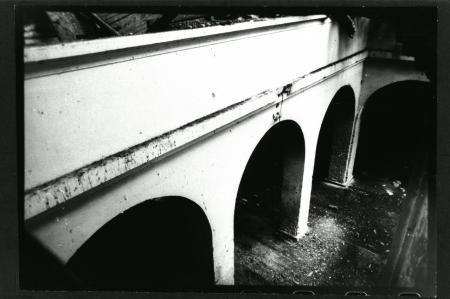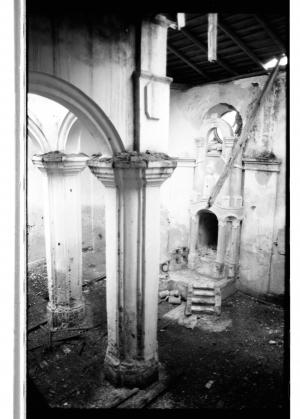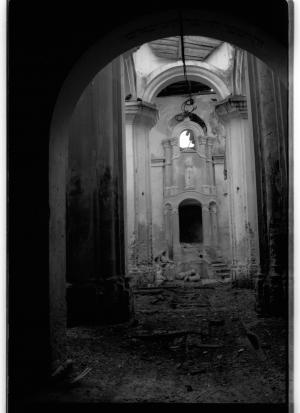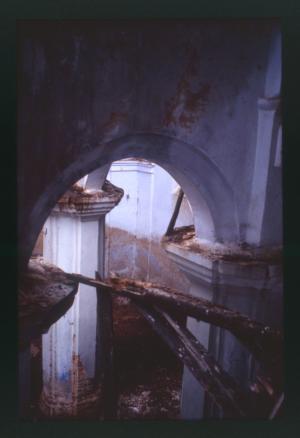Obj. ID: 126
Jewish Architecture Great Synagogue in Kalvarija - photos of 1993
To the main object: Great Synagogue in Kalvarija, Lithuania

The Great Synagogue, built in 1795–1803, is currently a ruined roofless building; its roof and the ceiling collapsed in 1992–96. Its walls are ca. 1.50 m thick, built of stone and brick, and plastered. The architecture combines Baroque and Neo-Classicist features.
In 1857 Leopold Salkowski measured the Great Synagogue and drew its ground plan, which shows that the main building was surrounded by annexes from three sides, except the southeast. The ground plan shows an almost square prayer hall that could be accessed by four stairs apparently descending from the vestibule. The prayer hall was surrounded with lower women’s sections from the southwestern and northeastern sides. The northwestern annex included a central vestibule with two entrance doors, with two kloyzn of almost square plan on its sides, equipped with stoves. The first floor above the northwestern annex was a gallery, as the text in the drawing states;20 it was accessed via exterior staircases on the southwestern and northeastern façades.
The segment-headed openings connecting the women’s section with the prayer hall are shown on the plan and currently can be seen in the lower part of the southwestern wall. Four pillars surrounding the bimah (strangely enough not shown on Sałkowski’s ground plan) were situated in the central part of the hall, thus dividing its space into nine bays. The traces of lunettes discernible above the windows provide evidence of the former vaulting of the hall. A postcard from the early 20th century shows the Great Synagogue surrounded with one- and two-storey annexes above which there rises an impressive Baroque gable. The building was covered with a high roof of ceramic tiles.
After the damage of WWI, the Great Synagogue underwent major reconstruction: the annexes on the three sides were razed, the openings that connected them with the prayer hall bricked up, and the building was reduced to the size of the prayer hall. The women’s section was installed on a new U-shaped gallery inside the hall; a staircase was placed in its northern corner. The original vaults were dismantled. Above the pillars new arches reinforced with iron bars were made in order to support a flat wooden ceiling over the prayer hall, and the synagogue was covered with a low half-gabled roof. A new Torah ark in an Egyptian-stylized Art Nouveau was erected.
Today (2007) the former Great Synagogue has an almost square plan (ca. 18 x 20 m), is built of bricks and stone, and plastered. All the façades are similar: they are pierced by segment-headed windows in their upper parts, and crowned with a molded cornice. The rectangular doorway (today bricked-up) is situated in the center of the northwestern façade facingSodų Street. A segment-headed door in the western side of the northeastern wall leads to the stairs towards the women’s gallery. An oculus is set in the center of the southeastern façade. It used to shed light upon the Torah ark, and its glazing bars were shaped as a Star of David. The prayer hall was thus lit by twelve windows, eleven of which were segment-headed, and the twelfth an oculus.
Inside, pilasters divide the walls into three bays. Three pillars surrounding the bimah (the fourth was pulled down), the Torah ark and the women’s gallery have survived. All these are built of brick and plastered. Remnants of blue paint of varied tints are visible on the walls and the central pillars; here and there planks of old floors can be noticed. An obliterated Hebrew verse זה שער לה' צדיקים יבאו בו (“This is the gate of the Lord; the righteous will enter through it,” Ps. 118:20), customarily placed above the entrance to a synagogue, is still visible on the central arch of the arcade supporting the women’s gallery. Four steps ascend to the three-tiered Torah ark. Its lower tier contained the niche for the Torah scrolls, flanked by couples of engaged colonnettes in the 1910s style. The central niche and the side colonnettes are spanned by segment-headed arches. The upper tier is also flanked by coupled engaged colonnettes spanned by a molded archivolt matching the oculus behind it. Crowned Tablets of the Law are set up on this tier.
In the Soviet period, the Great Synagogue was turned into a warehouse, which functioned there until 1981. Garages were attached to its southwestern wall, and removed after 1994. Today (2007) the building is in ruins, rapidly decaying.
(Text from Aliza Cohen-Mushlin, Sergey Kravtsov, Vladimir Levin, Giedrė Mickūnaitė, Jurgita Šiaučiūnaitė-Verbickienė (eds.), Synagogues in Lithuania. A Catalogue, vol. 1 (Vilnius, 2010)).
sub-set tree:
Cohen-Mushlin, Aliza, Sergey Kravtsov, Vladimir Levin, Giedrė Mickūnaitė, Jurgita Šiaučiūnaitė-Verbickienė (eds.), Synagogues in Lithuania. A Catalogue, 2 vols. (Vilnius: VIlnius Academy of Art Press, 2010-12)





















